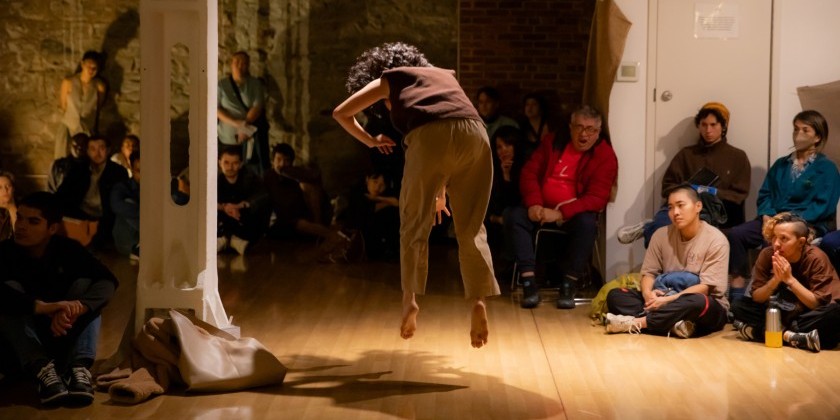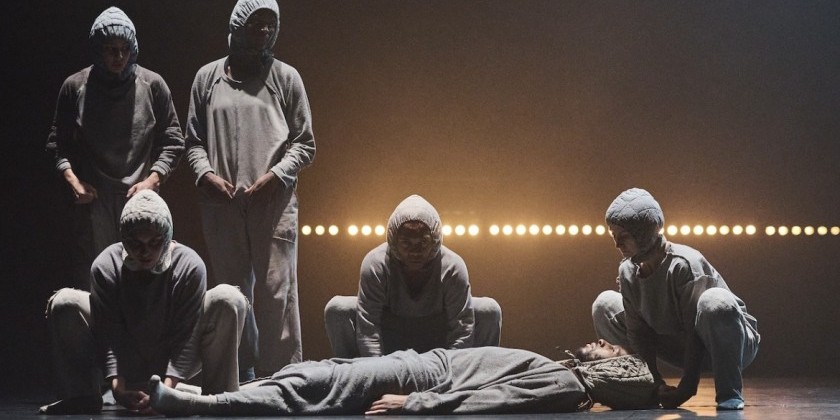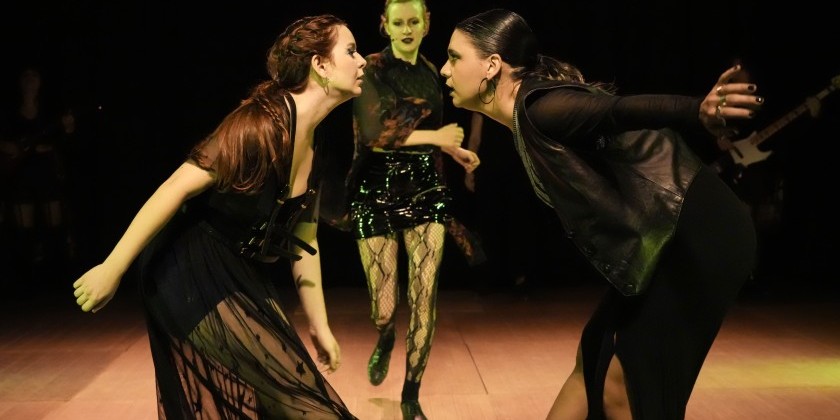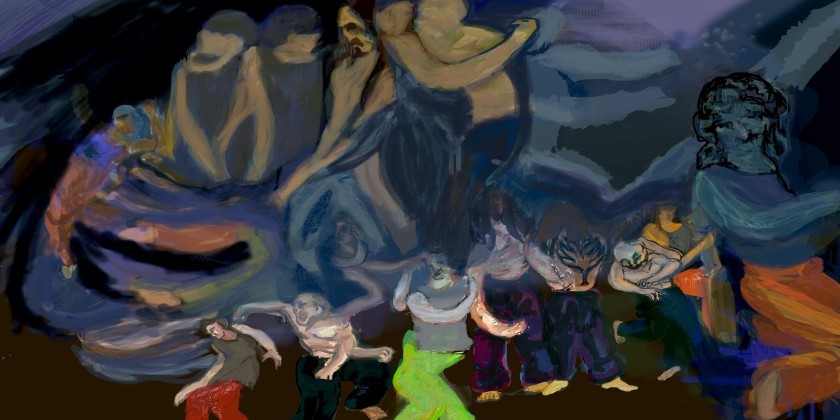AUDIENCE REVIEW: New Original Works (Week 1) at REDCAT, Los Angeles

Company:
Nguyễn Nguyên & Maria Gillespie: Zac Pennington, Jherek Bischoff & Steven Raker: Sheetal Gandhi, Ulka Mohanty & Mar
Performance Date:
July 30, 2015
Freeform Review:
Nguyễn Nguyên & Maria Gillespie: Bloom
Zac Pennington, Jherek Bischoff & Steven Raker: Crying
Sheetal Gandhi, Ulka Mohanty & Mark Gutierrez: In/Expiration
Week one of this year’s annual New Original Works Festival at REDCAT was 2/3 identity politics and 1/3 identity Dada—all 3 laboratory dance and live performances measured up to solid undertakings that could manageably tour and pique audience interests with contemporary views of culture, crooning and cosmos relativities.
In L.A. we hear helicopters everywhere—flying en route to roofs of hospitals and high rises and even at the beach where the L.A.P.D. patrols the very edge of the land from overhead. The noise can be unnerving and it travels a great distance. During the first work of the evening at Now Fest’s first week, the sound of a helicopter’s rotating propeller in Nguyễn Nguyên and Maria Gillespie’s Bloom was slowed down to a hypnotic drone that repetitively snuck back into the soundtrack of the piece at regular intervals—literally marking time. As the beating blades where heard, the bodies on stage moved in rhythm and recorded voices announced “This is a mouth, these are eyes, these are ears,” as if confirming the physical in front of the projected and delayed bodies as moving images through live feed video. Sound, vision and bodies coalesced into shifting and merging markers of time that reflected the content of the dance. One subject of the piece could also be a question, “What happens when you meld and mash up of two or more cultures onstage through movement and sound?” In Bloom, Vietnamese and Latin American culture is represented first by the two dancers’ physical attributes. But, how can we automatically assume someone is Vietnamese or Latina simply by the color of their skin or how they look? These are the kind of provocative questions that Bloom poetically asks us without feeling contrived. Audibly and visually, cultures were consciously arranged with a Spanish lullaby sung by a mother or grandmother broadcast along footage of bombs dropping on the lush forests and fields of Vietnam. The slowed down time and spoken/projected questions like “Are you afraid to be alone?” that Nguyên and Gillespie expressed are both haunting and positively reflective because they incite a will to remember and change our perceptions of history’s influences in our own lives and in contemporary culture. Bloom will be an eternal reminder for when I hear the constant whirs of helicopters in the city to question and maybe answer, “Is this home?” If we were to judge a dance’s power to associate specific phenomena like the ubiquitous sound of the helicopter makes, then the intermedia production Bloom has left an indelible mark on my subconscious and has overwhelmingly succeeded. Now when I hear the helicopters while I am trying to concentrate on a task, instead of getting annoyed with the noise, I will think of Nguyên and Gillespie rolling their bodies up in turf blankets in a protective layer against the distracting sounds of contemporary society—and I will no longer feel threatened by the flying machines.
The 2nd act of Now Fest’s opening night was Zac Pennington (singer, author, director), Jherek Bischoff (composer) & Steven Raker (choreographer) in Crying. As a whole, Pennington’s experimental dive into a Dadaist cabaret/solo opera with accompanying 4 string and 1 guitar exuded heartfelt emotion and surrealist hilarity. Stretching the idea of what rehearsed choreography and improvisation can look like on stage, Pennington’s moves appeared to be influenced by singers like Ian Curtis and Jarvis Cocker but evoked his own style of graceful affectation peppered with sinuous tenacity. Pennington’s hands should be insured because of their striking beauty and lithe strength. And when he uses them to pop enormous balloons with a carefully hidden barb a la Bond, you know he can’t be fully trusted because of his unpredictability. Dancer Allie Hankins came onto the scene as an accomplice to Pennington’s pseudo-masochistic foray into mic cord bondage while holding him steady and anchored to the stage with the cord encircling his groin so he did not fly or run away. At one point Zac stuffed the mic into Allie’s crotch and nuzzled into it while singing his face off and thus, pushed the piece into the realm of burlesque without showing any flesh. By saying that “This is what crying looks like”, Pennington has exposed the importance of hiding emotion on the inside without physically tearing up in order to protect one’s pride and self-confidence and resisting a revealing melt down. Developing a new meaning of crying is not a task I would have ever dreamed up and this is why Pennington and his entourage are so original and will do great things in the performing arts. I look forward to seeing more. Watching and hearing the Crying troupe in action put me in a trance – I was awestruck and could not even think of writing anything down in the moment.
For the last performance of the night, director and choreographer Sheetal Gandhi collaborated with dancer Ulka Mohanty while Mark Gutierrez mixed it up with a stand up base and guitar. During In/Expiration Gandhi and Mohanty enacted a running dialogue while or in between dancing as the ultimate multi-task. I can’t even answer a question and give change to someone else at my day job. Sheetal Gandhi and Ulka Mohanty can act, dance and verbalize so effortlessly that the seamless dualities of themselves as speakers and dancers literally became conjoined like Siamese twins or as a spiritual guide like Vishnu with multiple faces and voices. In the liner notes to the evening’s program, Gandhi included the phrase, “How do we turn a moment into a movement?” which is based on the work of Alicia Garza and the #BlackLivesMatter movement. Brought on stage, Gandhi creates moments that are physical movements not obviously ideological ones. Gandhi is adept in bringing large subjects of the cosmos, breath and matter and making them live, visually accessible actions in the form of words, dance and music that resemble prayer, meditation, and incantations. Using breathing as sound and conjuring Prana, the Hindu goddess of the breath, the dancers managed to project a palpable passion and energy into the theater that was undeniably genuine and therapeutic. Stomping their feet to mimic a drumming sequence, Gandhi and Mohanty became mediums to reckon with and not to question their non-preachy authoritative stances but accept them as guides to the cosmos. I am not usually a follower, but I would follow Gandhi and Mohanty because I could tell they are genuine in their knowledge and desire to teach and to experiment in dance and contemporary, cultural philosophy. Ending the evening with the two dancers lying on the floor panting “I can’t breathe” pushed the work into a protest sphere that even if you did not know whom Eric Garner was, the viewer could attach the phrase to an anti-pollution protest with ease. Although the piece brought up so many topics of concern in science, cosmogony, politics, and ethics, what I took away from the piece is that we all have the right to breathe, and anyone who tries to stop us from breathing should be held accountable and punished. It sounds almost like an insurmountable or ridiculous task in light of police brutality and corporate pollution but Gandhi and Mohanty made taking a stand and acting up laudable and even cheekily laughable in their slightly Nickelodeon style of voice delivery. On a humanitarian level, how many people are creating products or committing acts that inhibit our breathing in some way through bi-products or direct force? Sheetl Gandhi is at the forefront of the movement of artist practitioner as activist. We should all learn from her drive and continuous efforts to communicate for living quality lives through art.
It is exciting that so much creativity is happening in dance and performance in Los Angeles. A venue like REDCAT continues to amaze me with its diverse programming. Dedicating an annual festival that gives exposure to L.A. based groups is vital and admirable. Muchos kudos a REDCAT for giving us the 12th presentation of New Original Works Festival!
[Photo by: Steven Gunther @CalArts]











